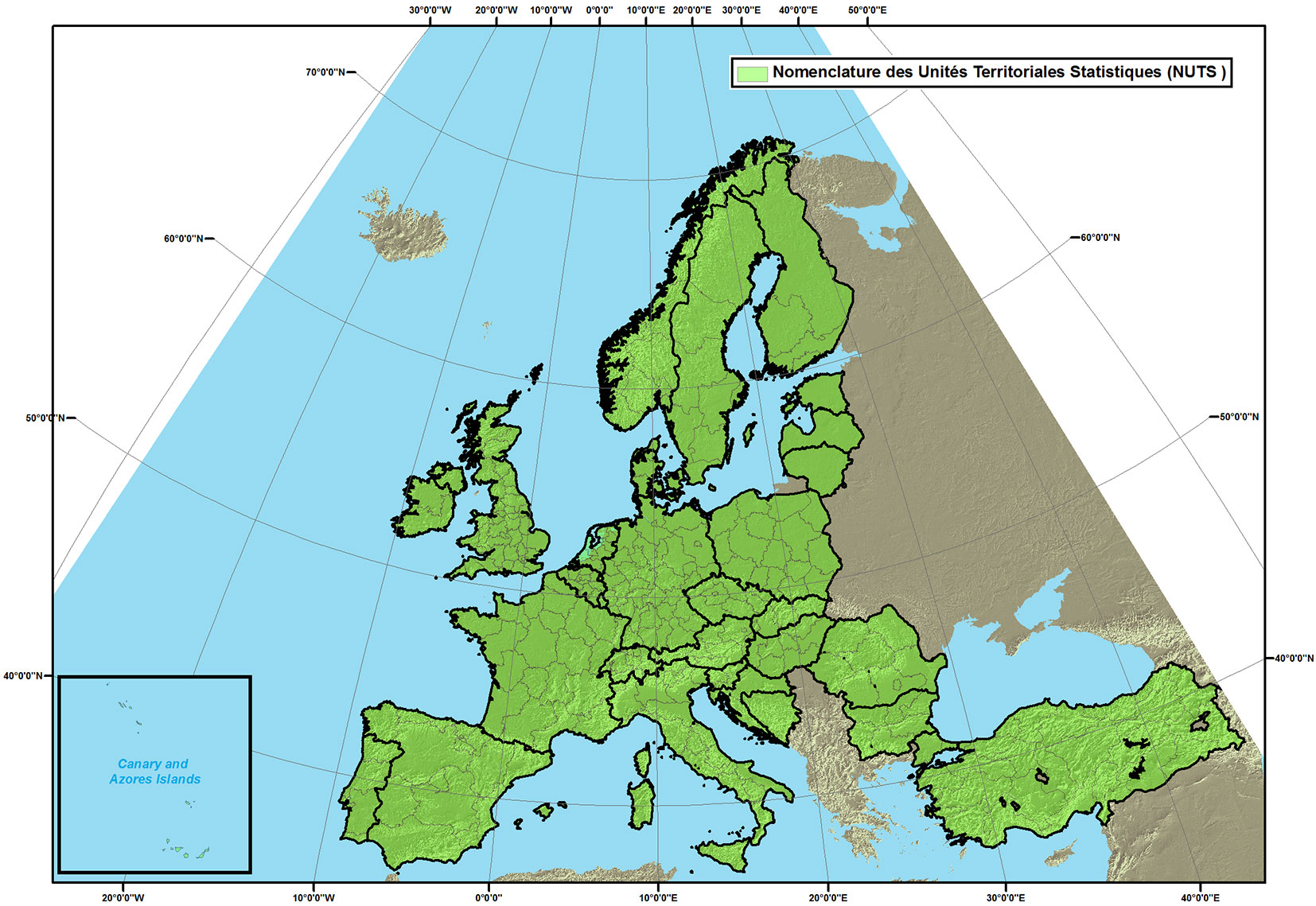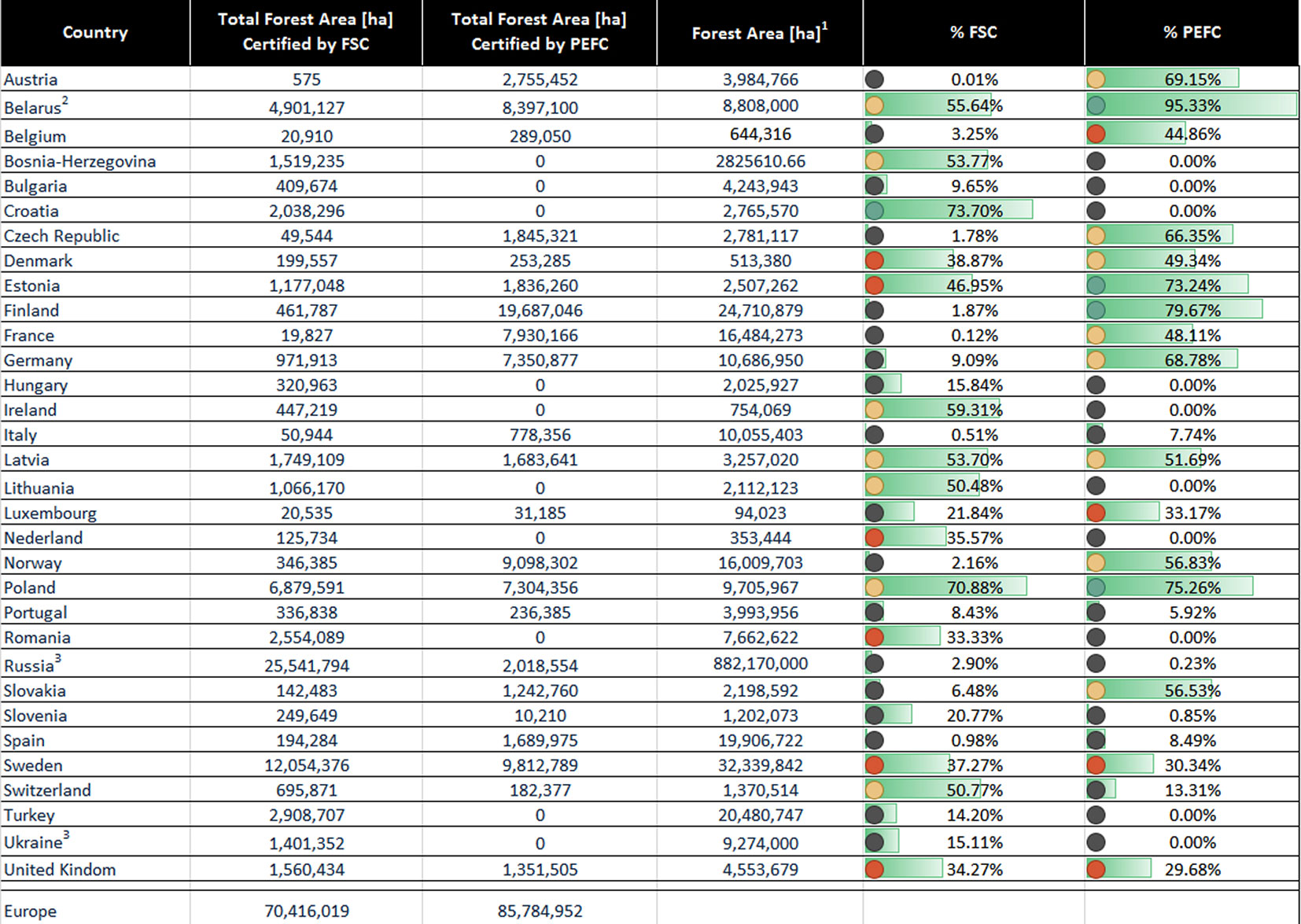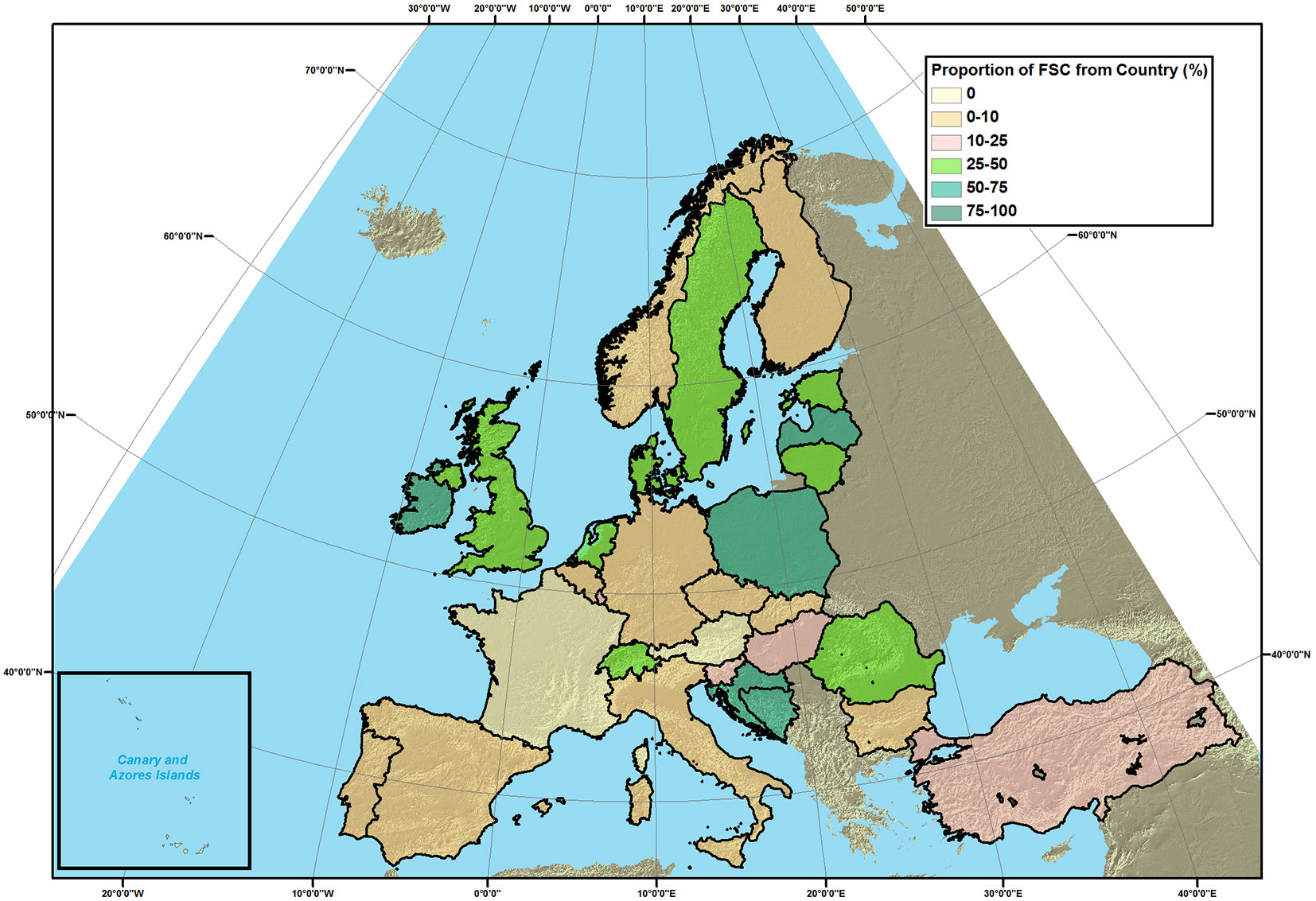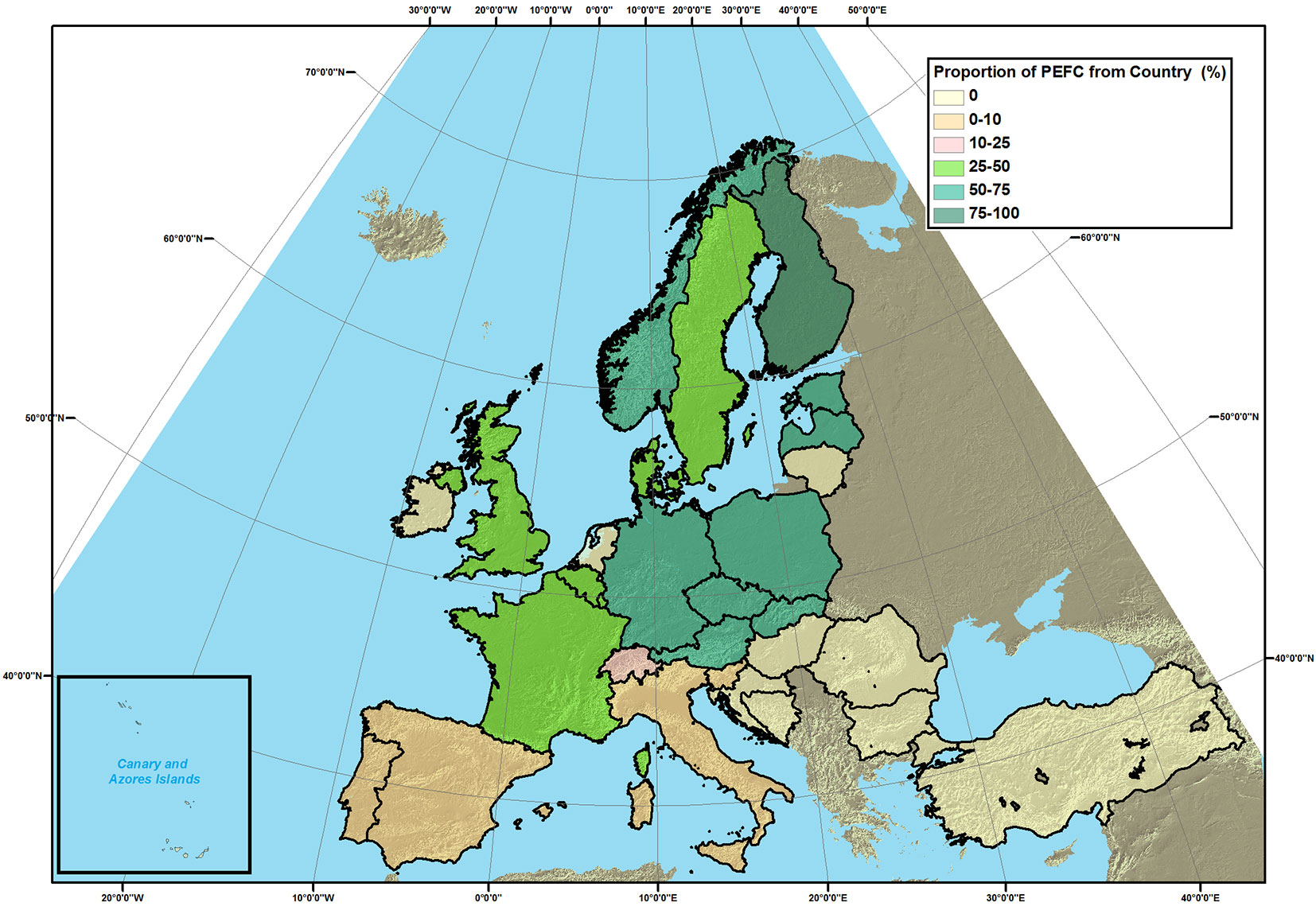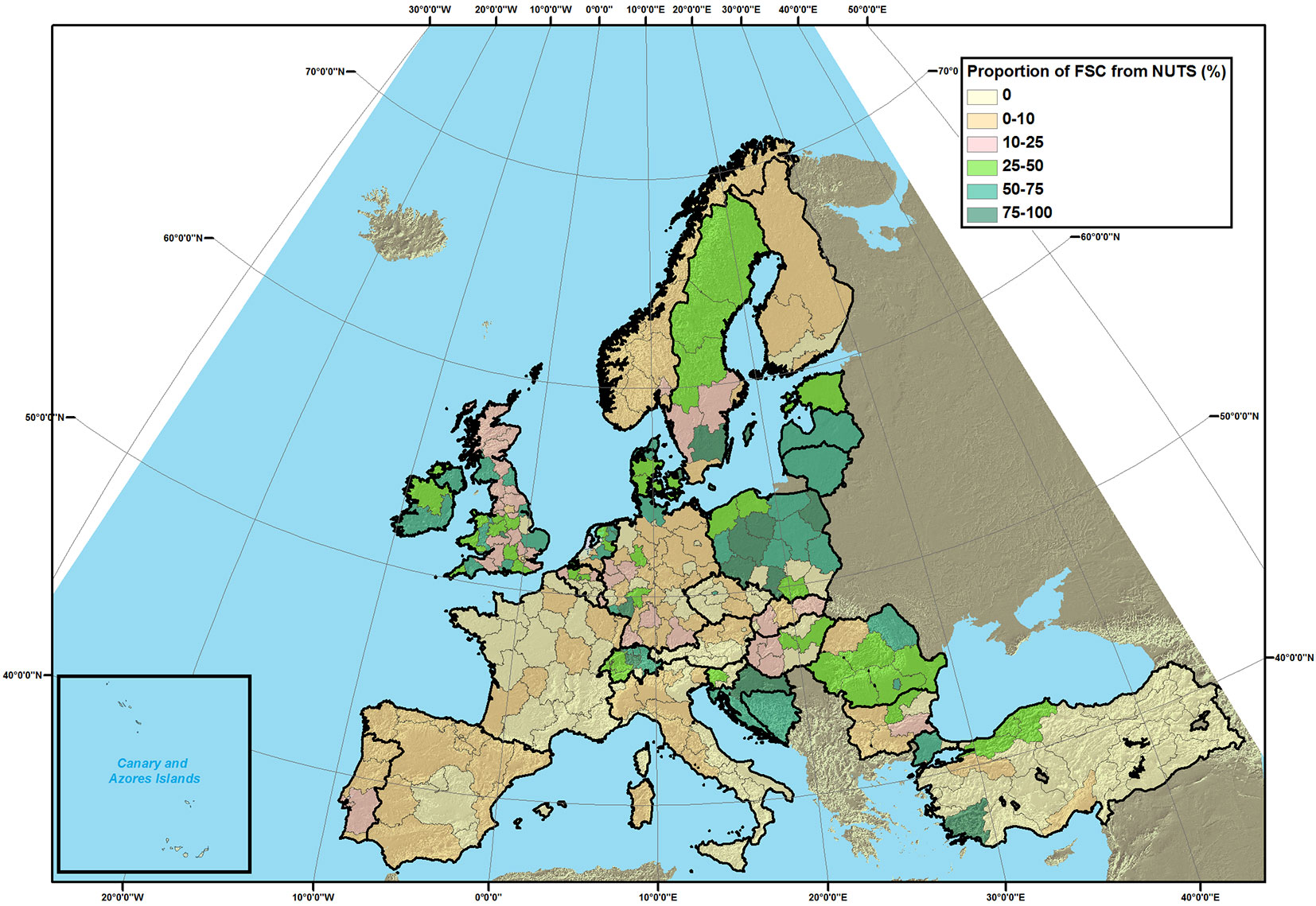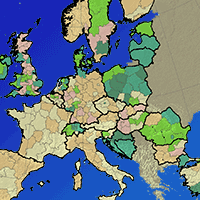
Forest certification map of Europe
iForest - Biogeosciences and Forestry, Volume 11, Issue 4, Pages 526-533 (2018)
doi: https://doi.org/10.3832/ifor2668-011
Published: Aug 01, 2018 - Copyright © 2018 SISEF
Technical Reports
Abstract
Forests cover nearly 40% of European land, with different country percentage and patchy distribution. The European forestry sector highlights that forest areas have different ownership: private (by firms, individual, or organizations) and public (State, communities or municipalities). The number of forestry holdings, size of landholding, and ownership types influence and drive forest management, governance and various other socio-economic linked issues. Moreover, forest owners determine management objectives and policies which influence the application of Sustainable Forest Management (SFM) practices. Several tools were developed to promote SFM, including forest certification. Numerous forest certification schemes are present across the world but the Forest Stewardship Council (FSC) and the Programme for the Endorsement of Forest Certification (PEFC) are those prevalent. However, a map of certified forests is lacking, although mapping would be essential to locate the percentage of forest that are certified to be sustainably managed. The study mapped forest certification across 43 European states, according to 499 FSC and 284 PEFC reports and assessed the proportion of certified forest area on public and private land and the rate of increase. This research was carried out collecting information on European certified forest companies/owners and locating geographically their forests at sub-national level (regions, NUTS 2). The database of the Joint COST Action FACESMAP/UNECE/FAO was an important data source. At European level, about six percent of the forest is certified under FSC scheme, while about seven percent under PEFC scheme. As forest certification is a useful tool to manage forests aiming at the integration of economic, ecological and social sustainability, the knowledge of the location and area of certified forest in Europe could be important in motivating decision makers to increase these sustainably managed areas.
Keywords
Forest Policy, Sustainable Forest Management, Forest Certification, Forest Owners, Forest Management
Introduction
Forests cover nearly 40% of European land, with different country percentage and patchy distribution and are characterized by various management practices for different forest types and ownership categories. Generally, the current situation of forest management in Europe reflects the large variety of environmental, economic and societal conditions that has developed throughout the history ([30]). At the European Union (EU) level, each member state defines its forest management approaches and forest policies ([6], [34]). In fact, the EU does not provide for a common forestry policy, but supports forestry sustainability through many policy frameworks including the EU Forestry Strategy (1998) and the EU Forest Action Plan (2006) defined with the Member States through the Standing Forestry Committee. In this context, Sustainable Forest Management (SFM) has become a recognized and widely spread concept both for the national forest plans and in the international forest policy ([24]) for the safeguarding the different values and services provided by forests to the community ([13]) and as a management system that seeks to balance social needs, economic aspects and ecological values associated with the forest, with consideration of future generations ([14]). SFM is a complex term and includes the entire forest ecosystem ([31]) which currently is assessed through several Principles, Criteria and Indicators ([20]). The present challenge of SFM is to take into account the multiple functions and services provided by forest to the society. The identification of these functions in forest management is important for assessing the environmental trade-offs of forestry ([20]), where applying SFM means maintaining multi-functionality of forest ([37]). Establishment of the framework of Criteria and Indicators based on sustainability Principles is a powerful tool for implementing SFM ([36], [22]). At the European level, many processes of international politics have influenced the evolution of the multifunctional framework of SFM. In the last years, FOREST EUROPE developed common strategies for protecting and sustainably manage forests through a participatory process, involving 46 participating countries in defining Criteria and qualitative and quantitative Indicators (CI-SFM project - ⇒ http://www.ci-sfm.org/). However, different obstacles in the efficient implementation of SFM Principles can occur, including ownership structure and fragmentation of forest properties.
Forest areas are privately owned by firms, individual, or organizations and publicly owned by State, communities or municipalities. According to different management objectives, ownership types and number of forestry holdings can influence forest management and connected socio-economic values ([35]). In Europe, 107 million hectares, or 52% of all forestland, are in hands of private owners ([7]). The majority, close to 16 million of individuals are so called non-industrial private forest (NIPF) owners, but in some countries like Sweden, Finland and Portugal there are also private corporations owning and managing large areas of forest land ([39]). Thus, private forest owners play a crucial role in European forestry, although most of them are managing very small forestlands ([4]).
SFM is a complex term and includes the entire forest ecosystem ([31]) which currently is assessed through several Indicators ([20]) and Principles. In recent years, the SFM concept in the private and public sectors has been extensively discussed and to promote SFM several tools have been developed, including forest certification ([5]). Forest certification is a voluntary instrument created in the ’90s to respond to the degradation of forests and to reduce illegal deforestation or mis-use of forests ([2]). Certification aims to ensure that management is undertaken through the observance of Forest Management (FM) standards, improving forest practices in environmentally sustainable, socially and economically viable ways. Numerous forest certification schemes are present across the world, but the Forest Stewardship Council (FSC) and the Programme for the Endorsement of Forest Certification (PEFC) are among the most recognized and diffused. Both schemes promote environmentally sustainable, socially responsible and economically viable forest management and they have been widely adopted in developed countries, particularly in Europe ([3]). Certification can improve forest management, allowing both consumers and companies to have an important role in forest conservation through their choice of certified products ([11]). Certified forests respect an agreed and strict forest management standards, guaranteeing well- and sustainably-managed forests. Forests with a good management contribute positively to local sustainable development and promote the mitigation of climate change effects at large scale ([23]).
The FSC sets out the global requirements (Principles & Criteria) for achieving FSC forest management certification. Thereafter, the National Standards Development Groups adapt the FM standard at the regional and/or national level, in order to reflect the diverse legal, social and geographical conditions of forests in different parts of the world, creating a local standard based on global principles. Nineteen National FSC Standards are present in Europe, and Certification Body interim standards are operational in countries where these have yet to be developed.
The PEFC is an umbrella organization that endorses national forest certification systems. Twenty-four Council Members have been endorsed by the PEFC in Europe. Stakeholders interested in forests and forestry are actively involved in the forest certification process and in the standards definition through participatory approaches. Therefore, it is important for forest certification process to inform local residents and stakeholders on forest management issues and their opportunities for participation. As reported by Romero et al. ([29]) many forest stakeholders now agree on the need to assess where, how, and to what extent the certification changed the ways of managing forests. Numerous studies have compared forest certification schemes, particularly on the basis of the stringency of their standards, and operational modes ([1], [18], [29]). Yet, the identification, quantification and mapping of certified forest areas according to certification schemes as well as by ownership categories needs to be improved. There is a growing concern about forest sustainability and data presented in the form of maps represent powerful sources of information, which can support international process, policy-making, decision-making, research activities as well as forest planning at various level ([21]).
The principal aim of the research presented in this paper is to develop maps on the forest certification diffusion in Europe by FSC and PEFC standards and geographically locate the certified forests at sub-national level. Another objective was to assess the proportion of certified forest area on public compared to private land and the rate of increase. These aims were pursued as maps can be a tool for promoting the sharing of data, to have more information on the forest certified areas geolocalization ([19]) to promote the Sustainable Forest Management and to encourage more transparent processes both for producers and users.
Material and methods
In order to develop the maps, a large set of data from European FSC and PEFC reports was collected and elaborated in a GIS (Geographic Information System) environment at the NUTS (Nomenclature of Territorial Units for Statistics) 2 level (i.e., Regions). The NUTS classification is a hierarchical system for dividing the economic territory of the EU for the purpose of the collection, development and harmonisation of European Union regional statistics, socio-economic analyses of the regions and the framing of EU regional policies.
The research process was divided in three stages. In the initial stage, a shapefile for all countries of the European region was created. In the second one, the database of certified forests in Europe (from the geographical point of view) for both FSC and PEFC was built, and in the final stage, the data were elaborated and the map of certified forests in Europe was completed.
In the forest certification map, national and sub-national boundaries, corresponding to the second level of NUTS classification, were used. The NUTS geo-data file was downloaded from the European Commission website (2010 update - “European NUTS layer”) and includes 36 countries (Tab. 1). For countries not covered by NUTS geo-data, sub-national boundaries were taken into account. In this case, to identify the exact location of the forests, a code (“European boundaries layer” - shapefile), similar to that of the NUTS code, was created for each area (Tab. 2). For Russia, only the European part was considered (up to the Urals mountain range). Subsequently, to identify the different boundaries of European countries, a new shapefile was created by the integration of the “European NUTS layer” and “European boundaries layer” at sub-national level using the QGis Software. The new shapefile includes all countries present in European area (Fig. 1).
Tab. 1 - Official number of second level NUTS in each country (source: ⇒ http://ec.europa.eu/ - updated: June 2014).
| Country | Country Code |
no. NUTS 2° level |
|---|---|---|
| Austria | AT | 9 |
| Belgium | BE | 11 |
| Bulgaria | BG | 6 |
| Cyprus | CY | 1 |
| Czech Republic | CZ | 8 |
| Germany | DE | 38 |
| Denmark | DK | 5 |
| Estonia | EE | 1 |
| Greece | EL | 13 |
| Spain | ES | 19 |
| Finland | FI | 5 |
| France | FR | 26 |
| Croatia | HR | 2 |
| Hungary | HU | 7 |
| Ireland | IE | 2 |
| Italy | IT | 21 |
| Lithuania | LT | 1 |
| Luxembourg | LU | 1 |
| Latvia | LV | 1 |
| Malta | MT | 1 |
| Netherlands | NL | 12 |
| Poland | PL | 16 |
| Portugal | PT | 7 |
| Romania | RO | 8 |
| Sweden | SE | 8 |
| Slovenia | SI | 2 |
| Slovakia | SK | 4 |
| United Kingdom | UK | 37 |
| Switzerland | CH | 7 |
| Iceland | IS | 1 |
| Liechtenstein | LI | 1 |
| Montenegro | ME | 1 |
| Macedonia | MK | 1 |
| Norway | NO | 7 |
| Turkey | TR | 26 |
| Andorra | AND | 1 |
Tab. 2 - Countries not covered by NUTS geo-data added to the second NUTS layer.
| Country | Country Code | No. Sub National Levels |
Code |
|---|---|---|---|
| Albania | AL | 26 | From AL01 to AL26 |
| Belarus | BLR | 6 | From BLR1 to BLR6 |
| Bosnia-Herzegovina | BIH | 1 | BIH1 |
| Georgia | GEO | 3 | From GEO1 to GEO3 |
| Moldova | MD | 1 | MD01 |
| Russia (EU) | RU | 54 | From RU01 to RU54 |
| Ukraine | UA | 25 | From UA01 to UA25 |
Fig. 1 - Shapefile from two layers: “Official European NUTS layer” and “European boundaries layer”. European countries involved in this project.
The data of certified forests areas were collected in June 2014 from FSC (⇒ http://info.fsc.org/) and PEFC (⇒ http://www.pefcregs.info/) on-line database, and were imported into a spread sheet. The structure of the database was made according to the data present on freely available public reports. In fact, FSC certification requires forest managers and auditors to make auditing and monitoring reports publicly available ([10]), while in PEFC certification only the principal data on the forests and owners are published on-line. Even if several Certification Bodies have different FSC report templates, the basic information required by FSC is always present. The data taken into account by two schemes were: type of certification scheme, country, NUTS ID, certificate code, license code, owner name, owner address, certification type, SLIMFs (Small and Low Intensity Managed Forests), certification body, total forest area, High Conservation Values (HCV1, HCV2. HCV3, HCV4, HCV5, HCV6 -[21]), NUTS name, NUTS code and number of schemes.
In this study, the certified area according to the two schemes were maintained separated because the exact location of the forest is given in the FSC reports but not in the PEFC reports. In the latter, the location of the forest owner is reported, but without information on the ownership type.
Data on certified area by ownership categories, and certification trends, was retrieved from Joint COST Action FACESMAP/ UNECE/FAO Enquiry on Forest Ownership in the ECE Region. The enquiry was launched in May 2015 and directed to the UNECE/FAO national correspondents and the COST Action FACESMAP respondents, who were asked to respond by the end of October 2015. One of the eleven topics in the survey contained questions on certified area by ownership categories in 2010 and 2015. Out of the 32 addressed countries, 14 countries provided complete answers on this issue and another four gave partial information. Thus, the full picture is not at hand, but the provided specific data on ownership still reveals some general features on the development of forest certification.
For each polygon of the NUTS 2 level, the percentage of certified forest was calculated considering the total forest area from the Corine Land Cover (CLC update 2012, scale: 1:100.000, Minimum Mapping Unit: 25 hectares). The CLC maps are available for: Austria, Belgium, Bosnia and Herzegovina, Bulgaria, Croatia, Czech Republic, Denmark, Estonia, Finland, France, Germany, Hungary, Ireland, Italy, Lithuania, Luxembourg, Netherlands, Norway, Poland, Portugal, Romania, Slovakia, Slovenia, Spain, Sweden, Switzerland, Turkey and United Kingdom. Instead, data from Forest Europe ([8]) and FAO ([9]) on the total forest area was respectively considered for Russia and Belarus.
The CLC classes related to forests and Others Wooded Land (OWL) categories were taken into account for each European Country and then joined into a single layer. The forest cover within each NUTS II level was obtained through overlapping of the NUTS layer with CLC layer. At this stage, the statistics on certified forest for each NUTS II in Europe were analyzed and compared at European level.
Results and discussion
According to the data, European FSC certified forest area at 2014 was about 70,416,000 hectares (Fig. 2). Among the 499 analysed FSC reports, 5 were certified as Forest Management - FM (nearly 50.000 ha) and 494 as Forest Management and Chain of Custody - FM/COC (about 70.366.000 ha). Regarding the type of certification, 363 were single certification (about 59,916,000 ha) and 136 were group certification (about 10,500,000 ha). Further, 284 PEFC reports were explored; whereof 97 were single certification (about 10,906,000 ha), 112 were group certification (about 30,241,000 ha) and 75 were regional certification (about 44,638,000 ha).
Regarding the percentage of certified forest, approximately 6% (or 70,416,000 ha - Fig. 3) of the overall forest area at European level is certified under the FSC scheme, while about 7% (or 85,785,000 ha) are certified under the PEFC scheme (Fig. 4). The countries with the highest certified areas was Croatia with about 73% of total forest area certified according to FSC standard, and Belarus, with about 95% of forest PEFC certified (Fig. 2). At NUTS level, the percentage of FSC certified forest largely varies (Fig. 5). The highest values were found in Poland, inside of PL22 and PL61, with all forests that resulted FSC-certified forests (Fig. 3). In general, one certification system is predominant in a given country, in line with the observation by Gafo Gomez-Zamalloa et al. ([11]) that reported that each EU Member State has opted for one or the other certification system. However, some forestland are certified simultaneously by both systems.
While in some European countries like Poland, Latvia, Denmark and Estonia, there is a significant interest in both schemes, other countries as Austria, Croatia, Finland, Ireland, demonstrate a pronounced preference for one of the two (Fig. 2). In the case of Poland, Latvia and Estonia the choice is related to government decision that requested the FSC forest management certification as a solution to specific policy problems ([2]): this resulted in a great increase in certified forest area.
In this study, certified forests have a total amount lower (< 35%) than the one officially reported by FSC ([10]) because in the present study Russia was considered only in part (European Russia). If we consider the certified forest area without Russia, we get the same area (about 44 milion ha) reported by FSC in 2014. On the other hand, European PEFC certified forest area was 85,784,952 hectares. Data on total forest area in Europe is derived from Corine Land Cover and differences exist between CLC results and other statistics collected with different methodologies such as Forest Europe - State of Europe’s forest; this is often the case for agriculture and forest statistics.
Each European country has a percentage of certified forest under the FSC scheme, while some countries (Bulgaria, Portugal, Turkey, Bosnia-Herzegovina, Croatia, Hungary, Ireland, Lithuania, Nederland, Romania and Ukraine) do not have any certified forest under the PEFC scheme. The spread of one scheme with respect to the other (FSC or PEFC), depends on many factors, including the distribution on ownership type, their management objectives and connections to the market for timber and non-timber forest products. Many companies, for example in Italy and Sweden, choose to be certified under both schemes for the chance to sell certified products according to the requests of the buyer and market trends, since the two schemes have not mutual recognition. Moreover, forest fragmentation seems to be an important factor, which affects not only the readiness to certify the forest, but also the choice of scheme. In relation to the perceived benefits, the certification process is often expensive in terms of cost and organizational effort for small forest owners ([38]). As reported by Di Lallo et al. ([4]), certification costs are the most critical limiting factor for smallholders. In Europe, the exact forest area managed by small forest owners is unknown, but it is estimated to represent about 60 % of the total forest area ([33], [4]). Currently, for both schemes, facilitations exist for smallholders, such as the Small or Low-Intensity Managed Forests program from FSC or the “group certification” that, under both schemes, allows a group of forest owners to join together to get the certification. However, results from the Joint COST Action FACESMAP/UNECE/FAO Enquiry indicates that the proportion of certified forest land is usually higher on public forest land that on private forest land (Tab. 3). Interesting exceptions are Austria and Finland, with a higher level of certified private forest land. One possible explanation for Austria might be the increased use of wood due to public relations campaigns conducted since the early 1990s ([28]), whereas for Finland, could be that the majority of forest owner’s (about 70%) is living in rural areas ([15]). Further, it is worth noting that there is an increasing trend in certification from 2010 to 2015, both on public and private land. In few countries, like Ireland and UK, all public forest land was certified already in 2010, while in Luxembourg, Slovak and Turkey no forest land was certified in 2010.
Tab. 3 - Proportion of certified forest land in some ECE countries. Source; Joint COST Action FACESMAP/UNECE/FAO Enquiry on Forest Ownership in the ECE Region.
| Country | Public Forest | Private Forest | Total | |||||
|---|---|---|---|---|---|---|---|---|
| Prop. Certified 2010 (%) |
Prop. Certified 2015 (%) |
Change 2010-2015 |
Prop. Certified 2010 (%) |
Prop. Certified 2015 (%) |
Change 2010-2015 |
Forest area 1000 ha |
Prop. Certified 2015 (%) |
|
| Austria | 67 | 67 | 0 | 47 | 75 | +31 | 3,869.0 | 74 |
| Belgium | 85 | 87 | +2 | 7 | 11 | +4 | 683.0 | 47 |
| Bulgaria | 9 | 24 | +15 | 0 | 1 | +1 | 3,812.0 | 21 |
| Croatia | 94 | 95 | +1 | 0 | 0 | 0 | 1,922.0 | 67 |
| Cyprus | 0 | 0 | 0 | 0 | 0 | 0 | 172.7 | 0 |
| Finland | - | 72 | - | - | 90 | - | 22,218.0 | 85 |
| France | 74 | 82 | +8 | 17 | 18 | +1 | 16,988.0 | 33 |
| Iceland | 0 | 0 | 0 | 0 | 0 | 0 | 49.1 | 0 |
| Ireland | 100 | - | - | 2 | - | - | 726.0 | - |
| Luxembourg | 0 | 87 | +87 | 0 | 6 | +6 | 88.7 | 44 |
| Netherlands | - | 62 | - | - | 28 | - | 376.5 | 45 |
| Russia | 3 | 5 | +2 | 0 | 0 | 0 | 814,930.5 | 5 |
| Serbia | 27 | 88 | +61 | - | - | - | 2,720.0 | 37 |
| Slovakia | 0 | 96 | +96 | 0 | 37 | +37 | 1,942.0 | 60 |
| Slovenia | 79 | 82 | +3 | 0 | 6 | +6 | 1,248.0 | 24 |
| Switzerland | 85 | 86 | +1 | 48 | 44 | -4 | 1,254.0 | 55 |
| Turkey | 0 | 19 | +19 | 0 | 0 | 0 | 12,666.2 | 19 |
| United Kingdom | 100 | 100 | 0 | 22 | 22 | 0 | 3,154.0 | 44 |
Conclusions
Over the recent years, the sensitivity of world public opinion on the issues of sustainable forest management in light of climate change and the resulting impacts has increased. Forests provide several ecosystem services from timber and non-wood forest products to carbon sequestration and recreation for human well-being ([26]). Indeed, in the last years, the focus of forest management has been shifted from timber to a broader range of values ([25]), through innovative forest governance approaches with mutual interactions of public and private actors ([32]). Forest certification promotes a forest management that is economically, socially and environmentally viable, and contributes to the preservation of ecosystem services provided by forest, also considering mitigation of climate change. Nevertheless, FSC forest management certification is linked also to forest ecosystem services in terms of biodiversity conservation, carbon storage, Non-timber forest products provision, watershed protection services and ecotourism values ([17]). Forest certification, although of voluntary nature, is one of the few tools currently existing that provides guarantee on Sustainable Forest Management and that, thanks to the Chain of Custody (CoC) standard, ensure the traceability of forest products, from harvesting to finished products ([16]). Forest certification process requires a forest management plan that has to include strategies for monitoring management practices to ensure that sustainabil-ity requirements are met ([13]).
FSC is a worldwide initiative, centralized and based on global Principles, while PEFC is an international membership association that adopted a bottom-up approach to governance and recognizes the activities of some autonomous certification schemes across the world.
Globally, the annual growth in area of certified forests has been quite constant.
This report analysed the situation in European countries. Within the FSC database, the public report summary of the main audit and sometimes others documents (surveillance audit, notes, etc.) are made available, while in the PEFC database only the main data of the certification are shown. A critical issue into the study process was to define the exact location of the certified forests. On the FSC online database, summaries of audit reports are publicly available, but each certification body employs a different template. It would be appropriate to create a common template or at least some common information by all the certification bodies to have a greater transparency and a better usability of data. Regarding PEFC database, there are no-exact location about the forests areas in the free available reports, but the location of the certificate holder is indicated. Further, CLC uses a Minimum Mapping Unit of 25 hectares and this implies that smaller areas of certain forests may not be adequately detected.
The forest certification map of Europe is certainly a useful starting point for understanding the network of the certified forests. Keeping it up to date, the map will allow to quantify geographically location changes over time of the forest certified and to assess if management options, property or other factors may affect the spread of forest certification in the future.
Increasing the forest products from sustainably managed forest and expanding the forest areas sustainably managed represent one of the four Global Objectives discussed in the UN Forum on Forests. Forests are vital for creating green economies, including green industries. In this forum, the green economy concept has been considered a major tool for achieving sustainable development and eradicating poverty for the more vulnerable categories of people, such as indigenous communities and women ([33]). Well-managed forests have tremendous potential to contribute to sustainable development and to a greener economy. Forest certification is widely recognized as a useful tool for moving towards SFM ([5]) aiming at the integration of economic, ecological and social sustainability ([27]) expecially in terms of community and workers’ rights ([2]). Forest certification can be considered one of the first examples of a shift from a state-centred governance of forest resources to non-state actors’ participation in forestry governance ([12]).
Which are the principal causes of the non-homogeneous geographical distribution in certified forest areas is an open question. One important factor is undoubtedly national public authorities and their respective forest laws, but also the different market conditions in European countries have a great importance. In effect, while forest certification is growing in much of the world regions, it does not yet appear to be deeply supported by local government policies ([2]). Knowing how much forest is certified in Europe and the economic, environmental and social benefits deriving from being certified could be the driver to motivate some European forest owner to become certified. In this respect, the availability of a dynamic map could be an additional tool to promote and spread certification in Europe and beyond.
Acknowledgements
This research was funded through STSM program by COST-ACTION FP1201 “Forest land ownership change in Europe: significance for management and policy” - FACESMAP. More information: ⇒ http://facesmap.boku.ac.at/
References
Gscholar
Gscholar
Gscholar
Gscholar
Gscholar
Gscholar
Gscholar
Gscholar
Authors’ Info
Authors’ Affiliation
National Research Council of Italy (CNR), Institute for Agricultural and Forestry Systems in the Mediterranean (ISAFOM), v. Cavour, 4-6 I-87036 Rende, CS (Italy)
Bruno Lasserre
Marco Marchetti
Department of Bioscience and Territory (DiBT), University of Molise, c.da Fonte Lappone snc, I-86090 Pesche, IS (Italy)
Department of forest resource management, Swedish University of Agricultural Sciences (SLU), 90183 Umeå (Sweden)
National Research Council of Italy (CNR), Institute for Agricultural and Forestry Systems in the Mediterranean (ISAFOM), v. Patacca 85, I-80056 Ercolano, NA (Italy)
Department of Innovation in Biological, Agro-Food and Forest System (DIBAF), University of Tuscia, v. San Camillo de Lellis, I-01100 Viterbo, VT (Italy)
Corresponding author
Paper Info
Citation
Maesano M, Ottaviano M, Lidestav G, Lasserre B, Matteucci G, Scarascia Mugnozza G, Marchetti M (2018). Forest certification map of Europe. iForest 11: 526-533. - doi: 10.3832/ifor2668-011
Academic Editor
Agostino Ferrara
Paper history
Received: Oct 26, 2017
Accepted: May 16, 2018
First online: Aug 01, 2018
Publication Date: Aug 31, 2018
Publication Time: 2.57 months
Copyright Information
© SISEF - The Italian Society of Silviculture and Forest Ecology 2018
Open Access
This article is distributed under the terms of the Creative Commons Attribution-Non Commercial 4.0 International (https://creativecommons.org/licenses/by-nc/4.0/), which permits unrestricted use, distribution, and reproduction in any medium, provided you give appropriate credit to the original author(s) and the source, provide a link to the Creative Commons license, and indicate if changes were made.
Web Metrics
Breakdown by View Type
Article Usage
Total Article Views: 55532
(from publication date up to now)
Breakdown by View Type
HTML Page Views: 45844
Abstract Page Views: 3829
PDF Downloads: 4871
Citation/Reference Downloads: 26
XML Downloads: 962
Web Metrics
Days since publication: 2688
Overall contacts: 55532
Avg. contacts per week: 144.61
Article Citations
Article citations are based on data periodically collected from the Clarivate Web of Science web site
(last update: Mar 2025)
Total number of cites (since 2018): 27
Average cites per year: 3.38
Publication Metrics
by Dimensions ©
Articles citing this article
List of the papers citing this article based on CrossRef Cited-by.
Related Contents
iForest Similar Articles
Research Articles
Indicators for the assessment and certification of cork oak management sustainability in Italy
vol. 11, pp. 668-674 (online: 04 October 2018)
Research Articles
The concept of green infrastructure and urban landscape planning: a challenge for urban forestry planning in Belgrade, Serbia
vol. 11, pp. 491-498 (online: 18 July 2018)
Short Communications
The Polish landscape changing due to forest policy and forest management
vol. 2, pp. 140-142 (online: 30 July 2009)
Research Articles
Communicating spatial planning decisions at the landscape and farm level with landscape visualization
vol. 7, pp. 434-442 (online: 19 May 2014)
Technical Advances
Forest planning and public participation: a possible methodological approach
vol. 5, pp. 72-82 (online: 12 April 2012)
Research Articles
Public participation GIS to support a bottom-up approach in forest landscape planning
vol. 6, pp. 347-352 (online: 29 August 2013)
Research Articles
Public participation in sustainable forestry: the case of forest planning in Slovakia
vol. 7, pp. 414-422 (online: 19 May 2014)
Review Papers
Public participation: a need of forest planning
vol. 7, pp. 216-226 (online: 27 February 2014)
Research Articles
Forest and tourism: economic evaluation and management features under sustainable multifunctionality
vol. 2, pp. 192-197 (online: 15 October 2009)
Research Articles
Use of multi-criteria analysis (MCA) for supporting community forest management
vol. 5, pp. 60-71 (online: 12 April 2012)
iForest Database Search
Search By Author
Search By Keyword
Google Scholar Search
Citing Articles
Search By Author
Search By Keywords
PubMed Search
Search By Author
Search By Keyword

